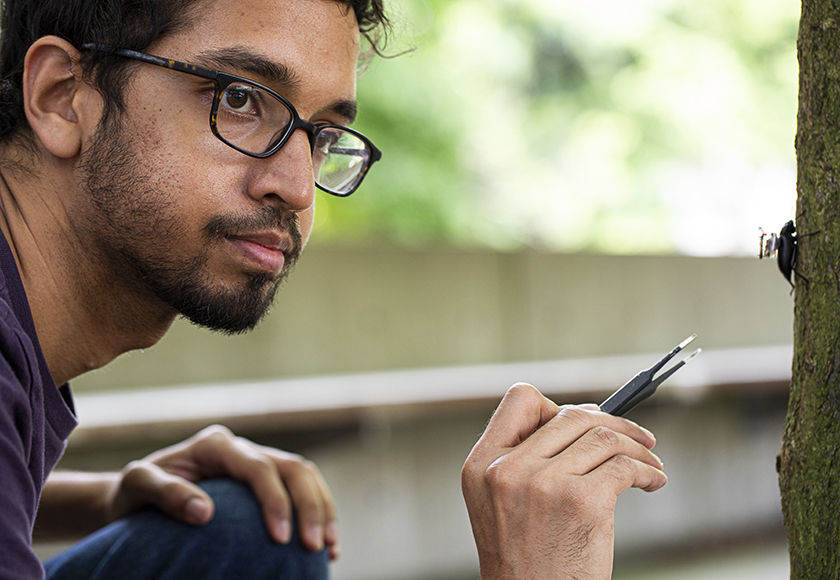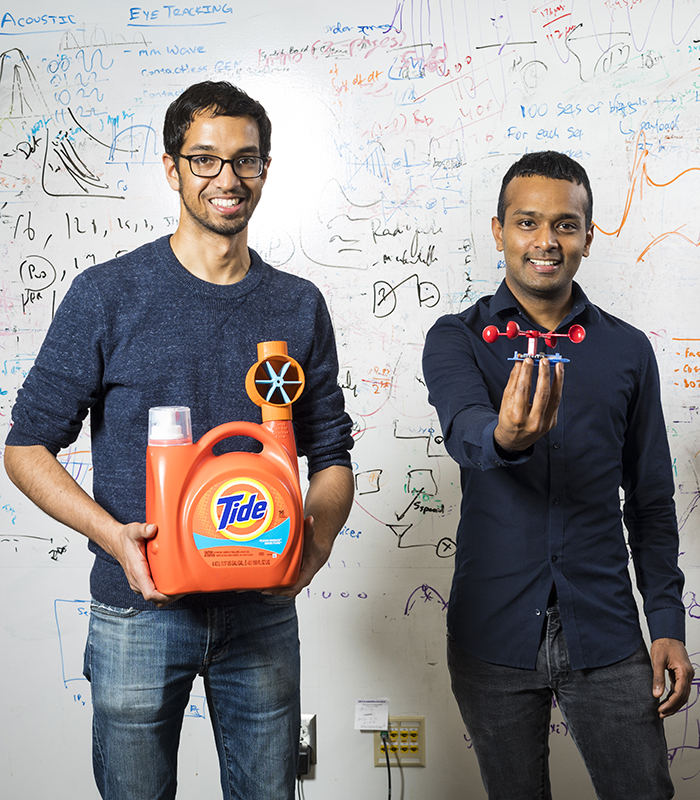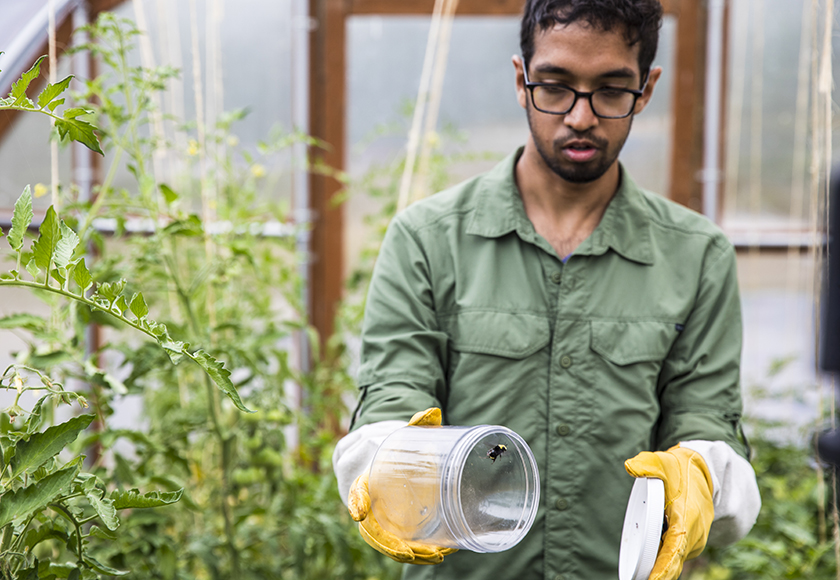No one could accuse Ph.D. student Vikram Iyer of just winging it. Since his arrival at the University of Washington, Iyer has advanced ground-breaking innovations in low-power wireless communication and computation to expand the Internet of Things, from 3D-printable wireless objects capable of storing and transmitting data, to insect-scale platforms that provide a bug’s eye view of the world. As a sign of just how his ideas have taken flight, today Iyer was named one of three recipients of the Paul Baran Young Scholar Award by the Marconi Society.
“By creating low cost, mobile IoT devices that can help answer questions and solve problems in any environment, Vikram’s work supports the Marconi Society’s mission of bringing the opportunity of the network to everyone,” said internet pioneer Vint Cerf, Chair of the Marconi Society, in a press release. “We are proud to welcome him to the Marconi family.”
The award recognizes innovative young engineers who show extraordinary technical acumen, creativity and promise for creating tomorrow’s information and communications technologies to support a digitally inclusive society. The honor came as no surprise to Iyer’s advisor, Allen School professor Shyam Gollakota, who recognized early on that his student would be a highflier.
”Vikram is a one-of-a-kind creative interdisciplinary researcher who is also humble,” said Gollakota. “He develops creative solutions that are at the intersection of hardware, software and biology. In so doing, he transforms what was once science fiction into reality.”
Iyer, a student in the UW Department of Electrical & Computer Engineering, began working with Gollakota in the Networks & Mobile Systems Lab in 2015. Among their first projects together was a collaboration with Allen School and ECE professor Joshua Smith of the Sensor Systems Laboratory on an ultra-low power system to provide wireless connectivity for implantable devices. Interscatter — short for intertechnology backscatter — employs a technique called backscatter communication to convert Bluetooth transmissions to WiFi and ZigBee signals over the air using commodity devices. As part of that project, Iyer and his collaborators created the first prototype contact lens antenna and an implantable neural recording interface capable of communicating directly with smartphones and smart watches. The team earned a Best Paper Award from the Association for Computing Machinery’s Special Interest Group on Data Communications (ACM SIGCOMM).
More recently, Iyer, Gollakota and their colleagues teamed up with professor Sawyer Fuller of the UW Mechanical Engineering Department’s Autonomous Insect Robotics (AIR) Lab to enable new wireless robotic technologies to take flight. The result was Robofly, the world’s first wireless fly-sized drone to achieve liftoff. Unlike previous insect-scale drones, Robofly does not require a wire to the ground to supply power and control signals — a significant achievement on the path toward autonomous robot flight. The team’s bio-inspired design featured dual flapping wings driven by a pair of piezoelectric actuators and directed by a lightweight microcontroller, which issues a series of pulses mimicking the action of a biological fly’s wings. An onboard photovoltaic cell converts light from a laser beam into electricity to power the onboard components without the need for heavy batteries, while the first sub-100 milligram boost converter and piezo driver sufficiently boosts the voltage to enable RoboFly’s ascent.
While news of Robofly’s exploits took off, Iyer recognized that there are limitations to what a drone insect could do. For one thing, robotic liftoff was difficult to achieve. And commercial drones are limited in how long they can fly uninterrupted.
“This made me wonder, rather than building a system that mimics an insect, could we augment live insects with sensing, computing and communication functionalities to create a mobile IoT platform?” Iyer explained. “We could use this platform to study micro-climates on large farms, answer questions about insects’ behavior or collect air quality data at a more granular level than by using a handful of stationary sensors.”
To explore the idea, Iyer set up an amateur beekeeping operation in a room in the Paul G. Allen Center on campus. The result was Living IoT, a mobile platform that combines sensing, computation, and communication packaged into a tiny wireless backpack light enough to be carried by a bumblebee. The entire system — antenna, envelope detector, sensor, microcontroller, backscatter transmitter, and rechargeable battery — weighed in at just 102 milligrams, or around half a bumblebee’s potential payload. Because the system did not need to power flight, only data collection, the team could keep the weight down by designing the system to transmit data and recharge the battery when the bee returned to the hive each day.
For his latest project, which was recently published in Science Robotics, Iyer’s insect subjects kept their feet on the ground. Building off of the previous work with bees, Iyer and his collaborators created a new wireless backpack containing a tiny, steerable video camera operated via Bluetooth. This time, they fitted their system on two species of beetle to demonstrate the potential for insect-scale robotic vision. Dubbed “BeetleCam,” the system emulates a real bug’s energy-efficient approach to gathering visual information, which relies on head motion independent of its body, while a built-in accelerometer prolongs the battery life by allowing the system to capture images only when the beetle is in motion. Weighing in at a mere 250 milligrams, or roughly half the payload the insects can carry, the system enables the beetles to freely navigate terrain and climb trees.
The team used what it learned to design the world’s smallest power-autonomous terrestrial robot with vision — proving, once again, that good things really do come in small packages.
“This is the first time that we’ve had a first-person view from the back of a beetle while it’s walking around. There are so many questions you could explore, such as how does the beetle respond to different stimuli that it sees in the environment?” Iyer said in a UW press release. “But also, insects can traverse rocky environments, which is really challenging for robots to do at this scale. So this system can also help us out by letting us see or collect samples from hard-to-navigate spaces.”
Iyer is the second UW student — and second from Gollakota’s lab — to earn this prestigious award. His labmate and frequent collaborator, Rajalakshmi Nandakumar (Ph.D. ‘19), now a faculty member at Cornell Tech, was honored in 2018 for her work on mobile apps for detecting life-threatening health issues. In addition to Iyer, the Marconi Society recognized two other researchers with 2020 Young Scholar Awards: Yasaman Ghasempour at Rice University (soon joining the Princeton University faculty) for her work on efficient, ultra-high speed network connections for next-generation IoT, and Piotr Roztocki at Canada’s Institut National de la Recherche Scientifique (INRS) for his work on scalable quantum resources for “future-proofing” telecommunications network security. The honorees were selected by an international panel of engineers drawn from leading universities and companies.
“Our Young Scholars are the braintrust that will put the speed, security and applications of next generation networks into the hands of billions,” said Cerf.
View Iyer’s Marconi Society profile here, and learn more about the 2020 Young Scholar Awards here. Watch a conversation between Iyer and Marconi Fellow Brad Parkinson here, and check out Iyer’s Geek of the Week profile on GeekWire here.
Congratulations, Vikram!




